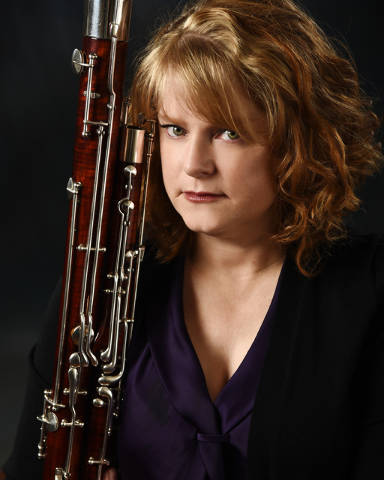Books, talks aimed at preserving Las Vegas’s music history

In the 1950s, there were more music jobs in Las Vegas than there were musicians to fill them. A musician could play a show at 8 p.m. and midnight and a different lounge at 10 p.m. and 2 a.m. and sometimes even after that, at 4 a.m.
“Since most of the hotels were on the same schedule, this was possible to do if you were energetic and motivated,” said Janis McKay, associate professor of bassoon at UNLV and author of “Played Out on the Strip: The Rise and Fall of Las Vegas Casino Bands.” She spoke to about 20 people during a Dec. 13 presentation at the Marjorie Barrick Museum of Art at UNLV.
The book, published in 2016 by the University of Nevada Press, follows Las Vegas hotels during the height of their role in musical entertainment from 1940-89. At the time each hotel employed a full-time band or orchestra, and they often had multiple lounge acts and entertainment revues to boot.
It’s just one of the many books chronicling Las Vegas’s golden age of entertainment and the inspiration behind the cliche “It was better when the Mob ran Las Vegas.” As the popularity of DJs and electronic dance music, or EDM, has soared, more musicians are taking on the task of recording the city’s musical history.
Jimmy Mulidore, a reedist who performed with Frank Sinatra and Elvis Presley and as a member of trombonist Carl Fontana’s Red Norvo Quintet, also wrote about music’s heyday in his memoir, “The Vegas Player,” published in 2015.
Then there’s recently departed Las Vegas Review-Journal columnist Mike Weatherford’s “Cult Vegas,” which touches on the wackier side of Vegas entertainment, and perhaps most recently, Las Vegas Events President Pat Christensen’s “Las Vegas Rock City: How Casino Central Became the Live-Music Capital of the World” (2017).
What drives the need to record this history? Mulidore, who also served as the music director for the Hilton and Flamingo hotels in the 1970s, said it’s partly because music in Vegas is “totally different now.”
“Today it’s a town full of people imitating dead people,” Mulidore said, referring to the many cover bands that perform hits of ’40s, ’50s and ’60s. “Imitation is a form of flattery, but it’s not anywhere close to the real thing of watching Frank Sinatra and the Rat Pack perform.”
In the 1960s, instrumental groups were in their heyday, and there were plenty: the Las Vegas Civic Orchestra, Las Vegas Boulevard Hotel Symphony, the Las Vegas Brass Sextet, the Las Vegas Jazz Septet, the Las Vegas Junior Symphony Orchestra, the Las Vegas Percussion Quartet and the Las Vegas Philharmonic. That doesn’t include the chamber music matinees, chorale ensembles and other, smaller groups, McKay said.
By the 1970s, corporate entities began to take over the casinos.
“They were determined to control all of the costs and to make every part of the hotel profitable,” McKay said. Casinos and hotels began switching to taped and synthesized music, making live musicians virtually obsolete.
McKay said that during the research of her book, one couldn’t talk about music in Las Vegas without someone mentioning the musicians’ strike of 1989. On June 3, musicians first walked off the stage at the Tropicana at the Folies Berger show to protest the changes.
The strike lasted for 7 1/2 months.
“That brought to an end the golden era of entertainment in Las Vegas,” McKay said.
McKay said the bubble for EDM and DJs is ready to burst, but she’s not sure what might replace it.
In the meantime, Mulidore is determined to keep remembering the good old days. In 2018 he’s set to put on a show called “We Were There” at The Bootlegger with “The Godfather” actor Gianni Russo, Dennis Bono and others.
“So now you’re going to hear from the horse’s mouth: We were there,” Mulidore said. “We were people that were actually right there with royalty of the entertainment business.”
Contact Madelyn Reese at mreese@viewnews.com or 702-383-0497. Follow @MadelynGReese on Twitter.